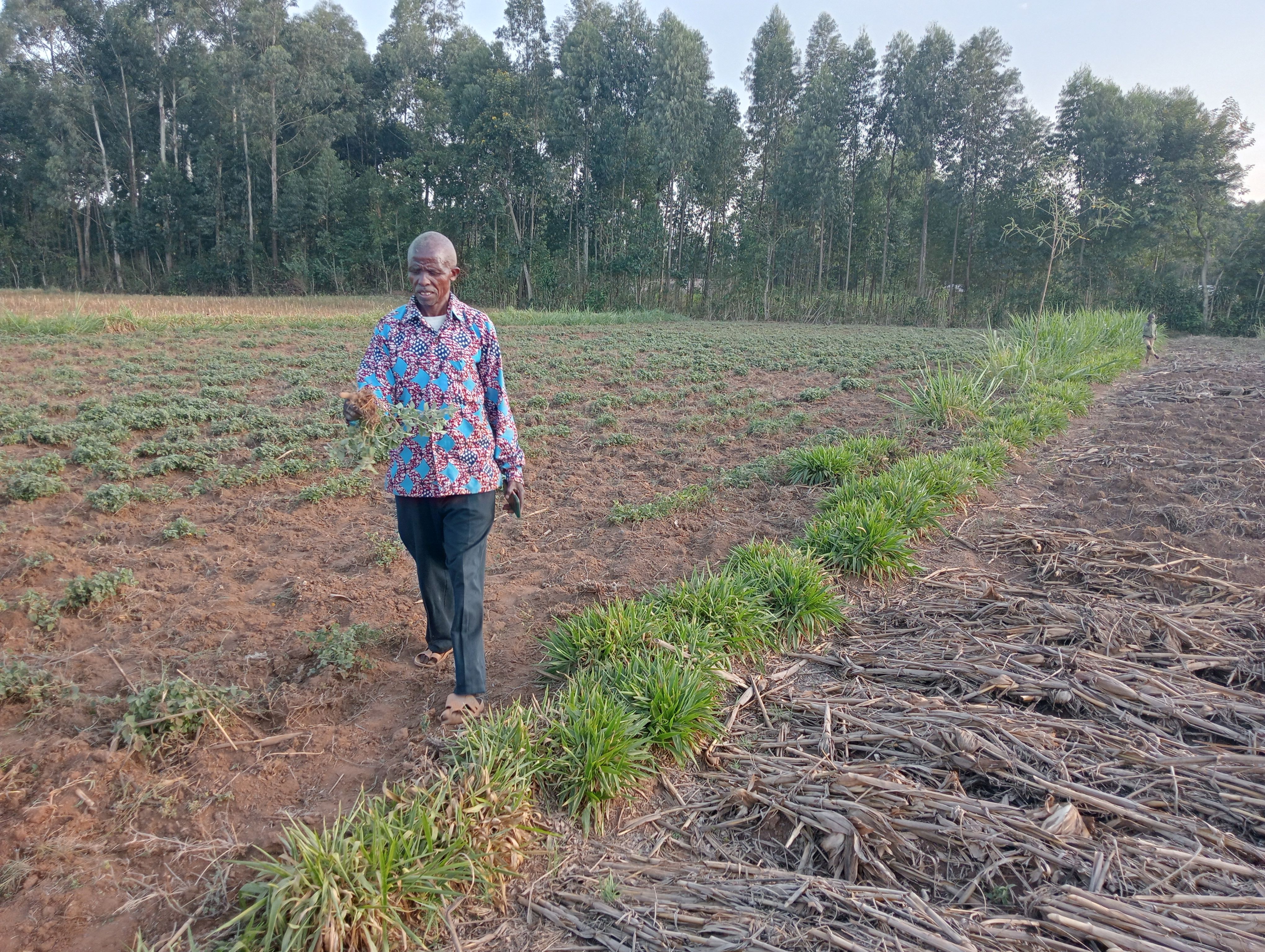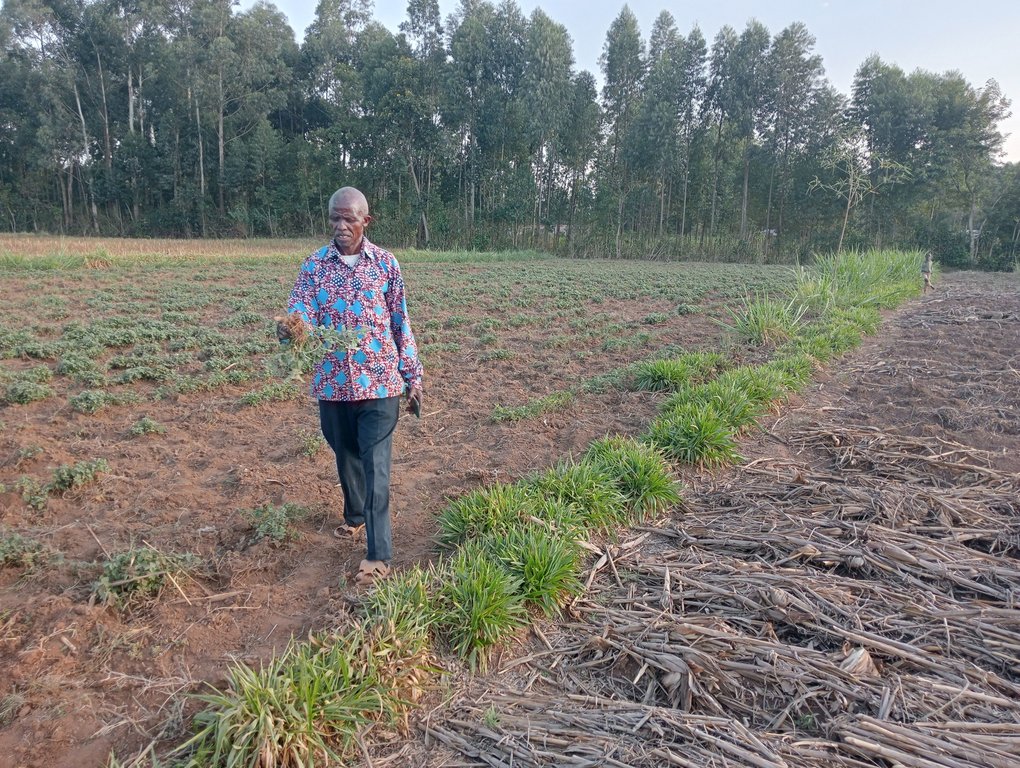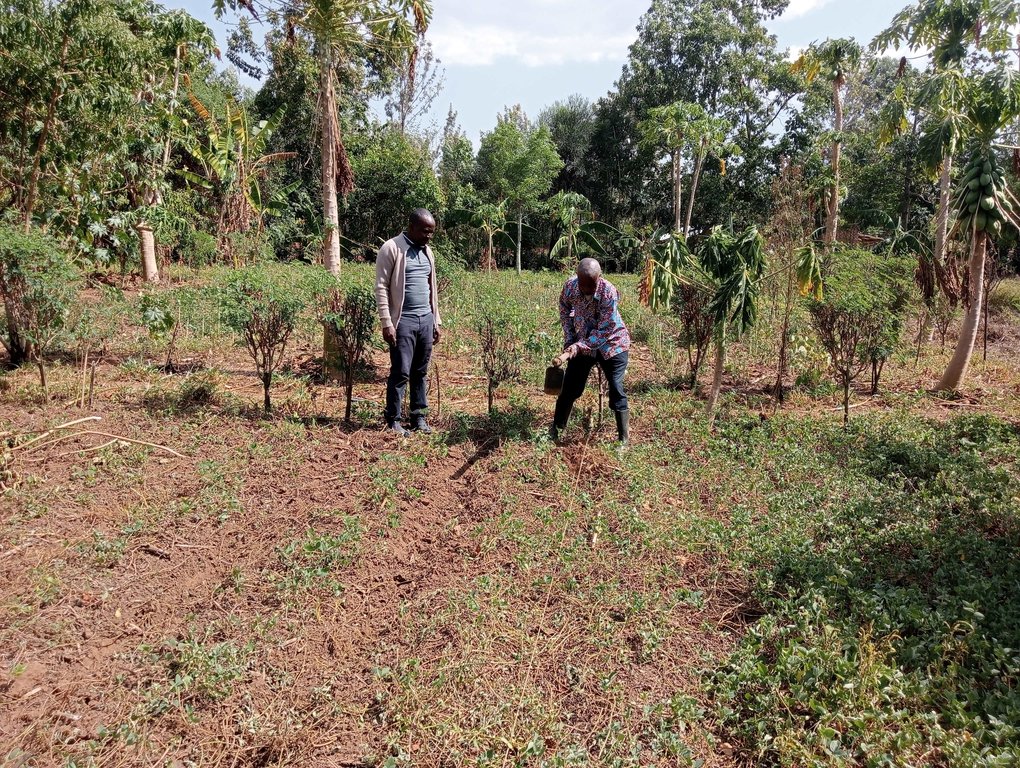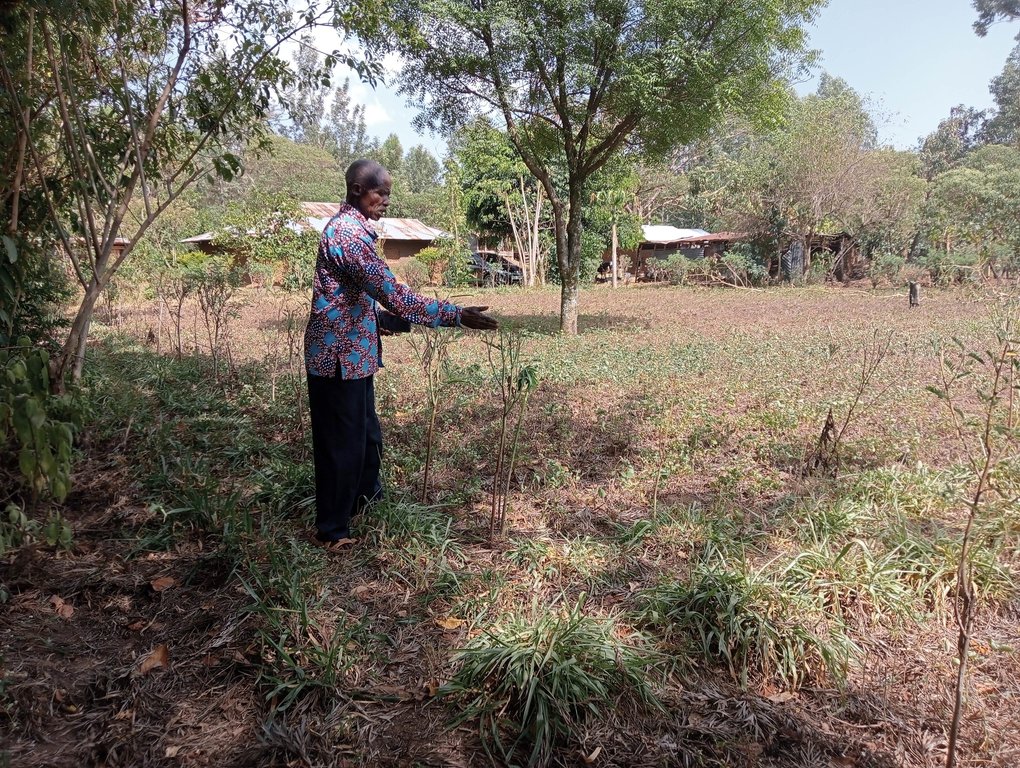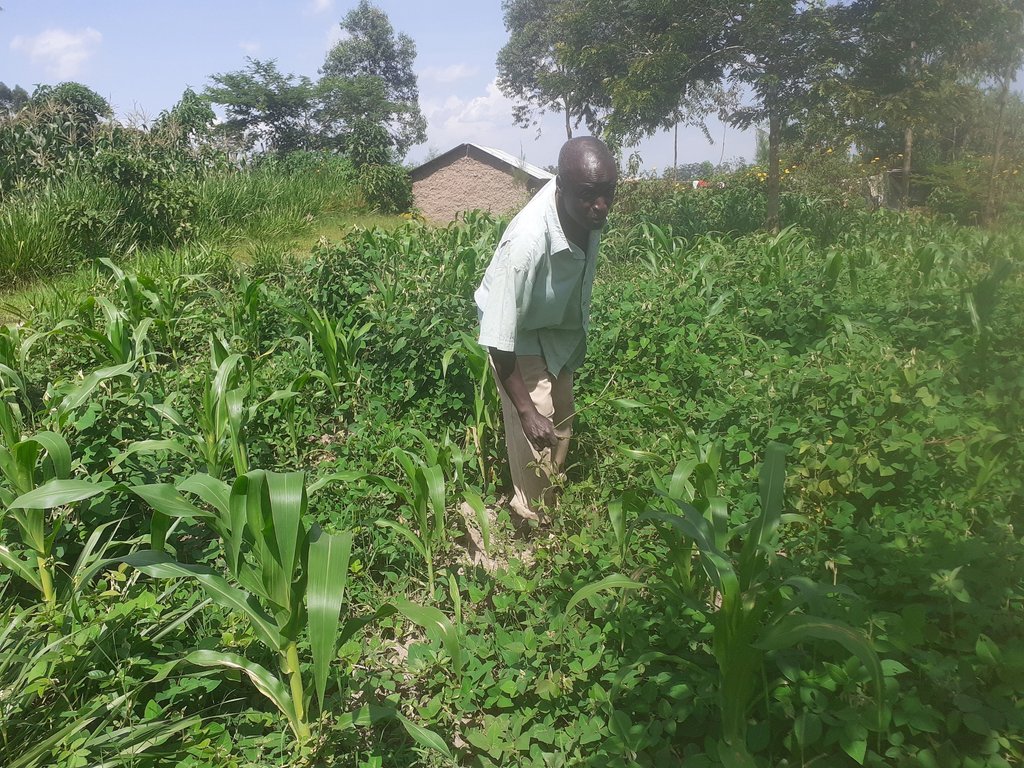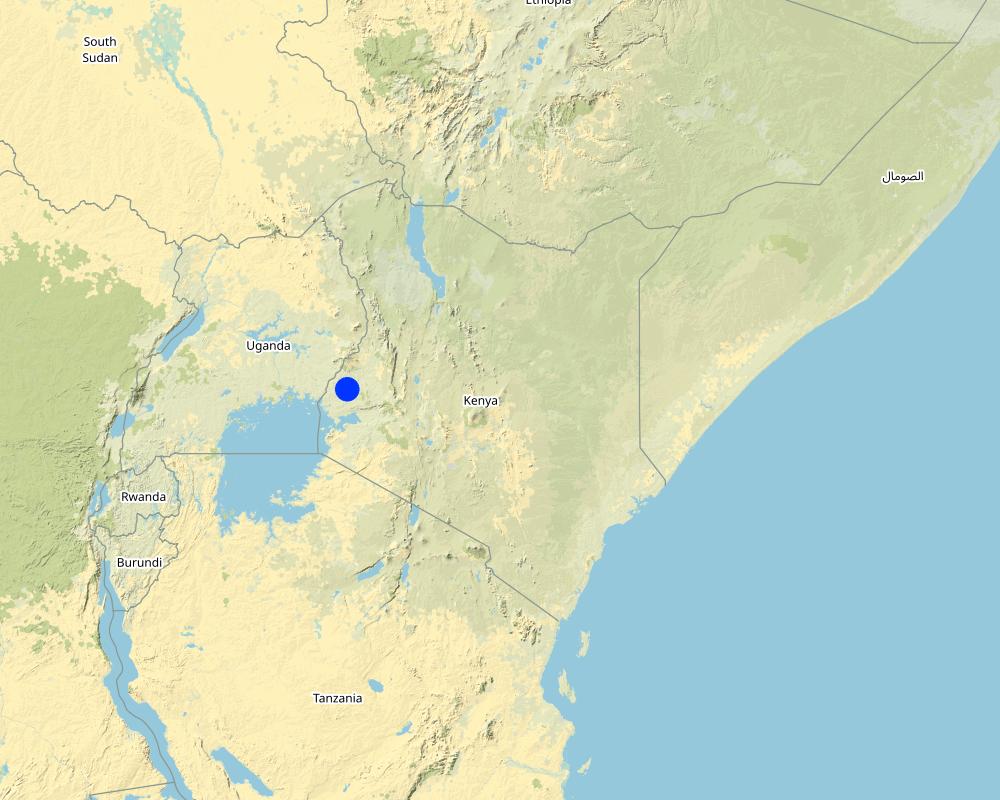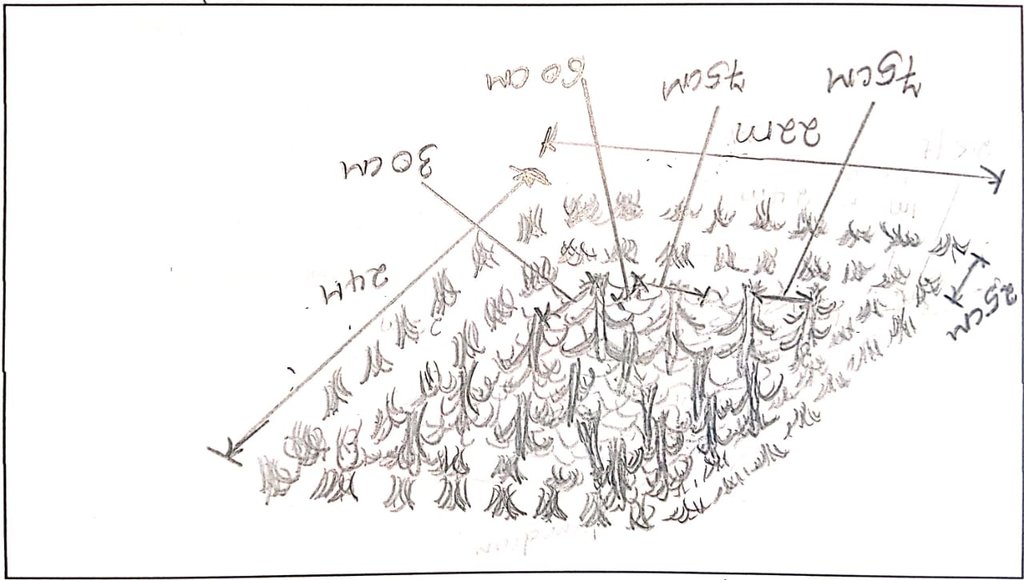Push-pull crop pest control [Kenya]
- Création :
- Mise à jour :
- Compilateur : William Akwanyi
- Rédacteurs : George Onyango, Innocent Faith, Noel Templer, JUSTINE OTSYULA
- Examinateurs : William Critchley, Rima Mekdaschi Studer
technologies_6701 - Kenya
Voir les sections
Développer tout Réduire tout1. Informations générales
1.2 Coordonnées des personnes-ressources et des institutions impliquées dans l'évaluation et la documentation de la Technologie
Personne(s)-ressource(s) clé(s)
exploitant des terres:
Keya Andrew Mulaa
Welthungerhilfe farmer
Kenya
Spécialiste GDT:
Spécialiste GDT:
Nom du projet qui a facilité la documentation/ l'évaluation de la Technologie (si pertinent)
Soil protection and rehabilitation for food security (ProSo(i)l)Nom du ou des institutions qui ont facilité la documentation/ l'évaluation de la Technologie (si pertinent)
Deutsche Gesellschaft für Internationale Zusammenarbeit (GIZ)Nom du ou des institutions qui ont facilité la documentation/ l'évaluation de la Technologie (si pertinent)
Alliance Bioversity and International Center for Tropical Agriculture (Alliance Bioversity-CIAT) - Kenya1.3 Conditions relatives à l'utilisation par WOCAT des données documentées
Le compilateur et la(les) personne(s) ressource(s) acceptent les conditions relatives à l'utilisation par WOCAT des données documentées:
Oui
1.4 Déclaration sur la durabilité de la Technologie décrite
Est-ce que la Technologie décrite ici pose problème par rapport à la dégradation des terres, de telle sorte qu'elle ne peut pas être déclarée comme étant une technologie de gestion durable des terres?
Non
Commentaires:
The technology has not adversely affected the farms of farmers who have implemented the technology.
2. Description de la Technologie de GDT
2.1 Courte description de la Technologie
Définition de la Technologie:
Push-pull technology is a strategy that controls pests, improves the productivity of cereal crops and fodder, and controls soil erosion.
2.2 Description détaillée de la Technologie
Description:
Push–pull technology was developed by the International Centre of Insect Physiology and Ecology (ICIPE) in collaboration with Rothamsted Research, (UK) in Kenya in the 1990s for the control of stemborer and striga weed in resource-poor maize farming systems. It is a strategy for controlling pests by using plants that repel them i.e., “push” crops and plants that trap pests i.e., “pull” crops. In Kakamega, Siaya, and Bungoma counties of western Kenya (i.e., the ProSoil project areas), the production of maize, millet, and sorghum has greatly been affected by poor soil fertility; insect pests, especially stemborer; and a parasitic weed called striga. Under the ProSoil project, Desmodium intortum is the main repellent “push” crop while napier grass (Pennisetum purpureum), brachiaria (Brachiaria decumbens), and mulatto (Brachiaria ruziziensis) are the main “pull” or trap plants.
In a typical push-pull system, the attractant “pull” plant is planted as a border around the field where the main crop e.g., maize, millet, or sorghum has been intercropped with the “push” crop. Desmodium produces repellent volatile chemicals that push away stemborer moths from the main field towards the edge where there is the “pull” or trap crop. The attractant trap plant emits volatile compounds which serve as a haven for the stemborers. As the stemborer moths lay eggs on the pull/ trap plant (in this case bracharia) and the eggs hatch and develop into larvae or caterpillar stage, a sticky substance like glue secreted by the bracharia physically traps the larvae; hence, inhibiting further development. In addition, desmodium stimulates the germination of striga and then effectively inhibits its growth through its roots' exudates.
“Push-pull” technology improves the productivity of cereal crops, controls soil erosion, and contributes to conservation agriculture (minimum tillage). Desmodium and bracharia are both high-quality animal fodder plants and because of their perennial nature, they maintain ground cover. Bracharia is rich in crude protein. Desmodium is a leguminous green manure cover crop and, therefore, it fixes nitrogen in the soil and improves soil organic matter. Desmodium does not suppress the main crop since it is not a climber.
One acre (0.4 ha) of land (in a push-pull system) requires about 0.75 kg of desmodium seeds and about 0.5 kg of brachiaria seeds. Desmodium is planted at a spacing of 75 cm between rows and 60 cm between plants in the same row. The cereal crop is established in rows parallel to the desmodium crop rows (e.g., 75 cm from row to row and 30 cm from plant to plant in the same row for maize). Brachiaria is planted in two shallow trenches (50 cm apart) and because the seeds are very tiny, they are sown on the surface of the trenches and covered with a very thin layer of soil to keep them in place, in darkness, until they sprout. They are later thinned to give a spacing of 25 cm between plants.
2.3 Photos de la Technologie
2.4 Vidéos de la Technologie
Commentaire, brève description:
https://www.youtube.com/watch?v=QbX1RWBGZI4&ab_channel=WilliamOnura
A farmer demonstrating how to prune desmodium roots using an African sword and how to break the ground/ soil using a chaka hoe.
Date:
11/02/2023
Lieu:
Andrew Mulla's farm in Lunyu Village, Khalaba Ward, Matungu Sub-county, in Kakamega County
Nom du vidéaste:
William Akwanyi
2.5 Pays/ région/ lieux où la Technologie a été appliquée et qui sont couverts par cette évaluation
Pays:
Kenya
Région/ Etat/ Province:
Kakamega County in western Kenya
Autres spécifications du lieu:
Khalaba Ward, Matungu Sub-county, in Kakamega County
Spécifiez la diffusion de la Technologie:
- répartie uniformément sur une zone
S'il n'existe pas d'informations exactes sur la superficie, indiquez les limites approximatives de la zone couverte:
- < 0,1 km2 (10 ha)
Est-ce que les sites dans lesquels la Technologie est appliquée sont situés dans des zones protégées en permanence?
Non
Commentaires:
There are no protected areas in the areas covered by this assessment. The stated area is the total area of the two fields where the information that was used in this documentation was collected from. Only one field (Andrew's) was used for most of the documentation e.g., field measurements and costs estimation. Nice photos of the technology were taken in the other field (Patrick's).
Map
×2.6 Date de mise en œuvre de la Technologie
Indiquez l'année de mise en œuvre:
2019
2.7 Introduction de la Technologie
Spécifiez comment la Technologie a été introduite: :
- par le biais de projets/ d'interventions extérieures
Commentaires (type de projet, etc.) :
Technology introduced by the ProSoil project.
3. Classification de la Technologie de GDT
3.1 Principal(aux) objectif(s) de la Technologie
- améliorer la production
- conserver/ améliorer la biodiversité
- s'adapter au changement et aux extrêmes climatiques et à leurs impacts
- atténuer le changement climatique et ses impacts
- créer un impact économique positif
3.2 Type(s) actuel(s) d'utilisation des terres, là où la Technologie est appliquée
Les divers types d'utilisation des terres au sein du même unité de terrain: :
Oui
Précisez l'utilisation mixte des terres (cultures/ pâturages/ arbres):
- Agro-sylvo-pastoralisme

Terres cultivées
- Cultures annuelles
- Cultures pérennes (non ligneuses)
- Plantations d’arbres ou de buissons
Cultures annuelles - Précisez les cultures:
- céréales - maïs
- céréales - sorgho
- cultures fourragères - trèfle
- cultures fourragères - graminées
- légumineuses et légumes secs - fèves
- légumes - autres
Système de cultures annuelles :
Maïs/sorgho/mil en culture intercalaire avec des légumineuses
Cultures pérennes (non ligneuses) - Précisez les cultures:
- bananier/plantain/abaca
- cultures fourragères - graminées
- fodder crops - legumes, clover
- canne à sucre
Plantations d'arbres et d'arbustes - Précisez les cultures:
- avocat
- arbres fourragers (Barbe jolote, Faux mimosa, Prosopis, etc.)
- fruits, autres
- manguier, mangostane, goyave
- papaye
Nombre de période de croissance par an: :
- 2
Précisez:
Crops are grown during the long and short rain seasons.
Est-ce que les cultures intercalaires sont pratiquées?
Oui
Si oui, précisez quelles cultures sont produites en culture intercalaire:
Cereal and legumes.
Est-ce que la rotation des cultures est appliquée?
Oui
Si oui, veuillez préciser:
The push-pull plot is left fallow with only the repellant and attractant crops.

Pâturages
Pâturage intensif/ production fourragère :
- Affouragement en vert/ zéro-pâturage
- Prairies améliorées
Type d'animal:
- bétail - laitier
- caprine
- volailles
Est-ce que la gestion intégrée cultures-élevage est pratiquée?
Oui
Si oui, veuillez préciser:
Desmodium and napier grass are fodder crops - fed to livestock. Manure from the animals is applied on the cereal crops.
Produits et services:
- economic security, investment prestige
- oeufs
- manure as fertilizer/ energy production
- viande
- lait
Espèces:
bétail - laitier
Nombre:
3
Espèces:
volailles
Nombre:
55
Espèces:
caprine
Nombre:
4
3.3 Est-ce que l’utilisation des terres a changé en raison de la mise en œuvre de la Technologie ?
Est-ce que l’utilisation des terres a changé en raison de la mise en œuvre de la Technologie ?
- Non (Passez à la question 3.4)
3.4 Approvisionnement en eau
Approvisionnement en eau des terres sur lesquelles est appliquée la Technologie:
- pluvial
Commentaires:
Crop establishment is dependent on availability of rainfall.
3.5 Groupe de GDT auquel appartient la Technologie
- système de rotation (rotation des cultures, jachères, agriculture itinérante)
- gestion intégrée cultures-élevage
- lutte intégrée contre les ravageurs et les maladies (incluant l'agriculture biologique)
3.6 Mesures de GDT constituant la Technologie

pratiques agronomiques
- A1: Couverture végétale/ du sol
- A2: Matière organique/ fertilité du sol
- A3: Traitement de la couche superficielle du sol

pratiques végétales
- V2: Herbes et plantes herbacées pérennes
3.7 Principaux types de dégradation des terres traités par la Technologie

érosion hydrique des sols
- Wt: perte de la couche superficielle des sols (couche arable)/ érosion de surface

érosion éolienne des sols
- Et: perte de la couche superficielle des sols (couche arable)
3.8 Prévention, réduction de la dégradation ou réhabilitation des terres dégradées
Spécifiez l'objectif de la Technologie au regard de la dégradation des terres:
- prévenir la dégradation des terres
4. Spécifications techniques, activités, intrants et coûts de mise en œuvre
4.1 Dessin technique de la Technologie
Spécifications techniques (associées au dessin technique):
Trap crop at the edge (brachiaria): 50 cm x 25 cm
Repellant crop (desmodium): 75 cm x 60 cm
Cereal crop (maize intercropped with desmodium): 75 cm x 30 cm
Auteur:
William Akwanyi
Date:
11/02/2023
4.2 Informations générales sur le calcul des intrants et des coûts
Spécifiez la manière dont les coûts et les intrants ont été calculés:
- par superficie de la Technologie
Indiquez la taille et l'unité de surface:
0.0528 ha
autre/ monnaie nationale (précisez):
KES
Indiquez le taux de change des USD en devise locale, le cas échéant (p.ex. 1 USD = 79.9 réal brésilien): 1 USD = :
124,21
Indiquez le coût salarial moyen de la main d'œuvre par jour:
KES 250.00
4.3 Activités de mise en place/ d'établissement
| Activité | Calendrier des activités (saisonnier) | |
|---|---|---|
| 1. | Land preparation | Before rains |
| 2. | Seed sourcing | Before rains |
| 3. | Planting | After rains |
Commentaires:
Land should be ploughed only when there are stubborn weeds.
4.4 Coûts et intrants nécessaires à la mise en place
| Spécifiez les intrants | Unité | Quantité | Coûts par unité | Coût total par intrant | % des coût supporté par les exploitants des terres | |
|---|---|---|---|---|---|---|
| Main d'œuvre | Land preparation | Man-days | 4,0 | 250,0 | 1000,0 | 100,0 |
| Equipements | Slasher | No. | 1,0 | 70,0 | 70,0 | |
| Equipements | African machete (panga) | No. | 1,0 | 80,0 | 80,0 | |
| Equipements | Jab planter | No. | 1,0 | 1000,0 | 1000,0 | |
| Matériel végétal | Bracharia seeds | Kgs | 0,1 | 420,0 | 42,0 | |
| Matériel végétal | Desmodium seeds | Kgs | 0,26 | 420,0 | 109,2 | |
| Matériel végétal | Maize seeds | Kgs | 1,0 | 180,0 | 180,0 | 100,0 |
| Engrais et biocides | Manure | Wheelbarrows | 30,0 | 70,0 | 2100,0 | |
| Coût total de mise en place de la Technologie | 4581,2 | |||||
| Coût total de mise en place de la Technologie en dollars américains (USD) | 36,88 | |||||
Si le coût n'est pas pris en charge à 100% par l'exploitant des terres, indiquez qui a financé le coût restant:
ProSoil project through Welthungerhilfe.
Commentaires:
The ProSoil project through Welthungerhilfe provided slashers, African swords, and jab planters to the farmers through their groups. The costs of these implements are KES 350/- for a slasher, KES 400/- for a panga (machete), and KES 5,000/- for a jab planter. It is assumed that the farmer will be able to use these implements over a period of 5 years before these implements will have depreciated to a point where they will not be useable. The cost is thus spread over the years when the farmer will be able to use the implement.
4.5 Activités d'entretien/ récurrentes
| Activité | Calendrier/ fréquence | |
|---|---|---|
| 1. | Shallow weeding | Twice during maize crop growing period |
| 2. | Ripping | Before maize re-establishement |
| 3. | Root management | Before maize re-establishement |
4.6 Coûts et intrants nécessaires aux activités d'entretien/ récurrentes (par an)
| Spécifiez les intrants | Unité | Quantité | Coûts par unité | Coût total par intrant | % des coût supporté par les exploitants des terres | |
|---|---|---|---|---|---|---|
| Main d'œuvre | Shallow weeding | Man-days | 2,0 | 250,0 | 500,0 | |
| Main d'œuvre | Root management | Man-days | 2,0 | 250,0 | 500,0 | |
| Main d'œuvre | Ripping | Man-days | 4,0 | 250,0 | 1000,0 | |
| Equipements | Shallow weeder | No. | 1,0 | 80,0 | 80,0 | |
| Equipements | Chaka hoe | No. | 1,0 | 130,0 | 130,0 | |
| Equipements | African machete (panga) | No. | 1,0 | 80,0 | 80,0 | |
| Coût total d'entretien de la Technologie | 2290,0 | |||||
| Coût total d'entretien de la Technologie en dollars américains (USD) | 18,44 | |||||
Si le coût n'est pas pris en charge à 100% par l'exploitant des terres, indiquez qui a financé le coût restant:
ProSoil project through Welthungerhilfe.
Commentaires:
The ProSoil project through Welthungerhilfe provided Shallow weeders, pangas (machete), and chaka hoes to the farmers through their groups. The costs of these implements are KES 400/- for a slasher, KES 400/- for an African sword, and KES 650/- for a jab planter. It is assumed that the farmer will be able to use these implements over a period of 5 years before these implements will have depreciated to a point where they will not be useable. The cost is thus spread over the years when the farmer will be able to use the implement.
4.7 Facteurs les plus importants affectant les coûts
Décrivez les facteurs les plus importants affectant les coûts :
Rate of man-days vary from one place to another, farmer to farmer, and with type of work.
Exchange rate for February 2023, source: European Commission/ InfoEuro online at https://commission.europa.eu/funding-tenders/procedures-guidelines-tenders/information-contractors-and-beneficiaries/exchange-rate-inforeuro_en
5. Environnement naturel et humain
5.1 Climat
Précipitations annuelles
- < 250 mm
- 251-500 mm
- 501-750 mm
- 751-1000 mm
- 1001-1500 mm
- 1501-2000 mm
- 2001-3000 mm
- 3001-4000 mm
- > 4000 mm
Spécifiez la pluviométrie moyenne annuelle (si connue), en mm:
1300,00
Spécifications/ commentaires sur les précipitations:
Monthly rainfall variability is high with some months such as January recording less than 5 mm of total rainfall.
Indiquez le nom de la station météorologique de référence considérée:
Kakamega Meteorological Station
Zone agro-climatique
- humide
The climate in the area favours most agricultural activities.
5.2 Topographie
Pentes moyennes:
- plat (0-2 %)
- faible (3-5%)
- modéré (6-10%)
- onduleux (11-15%)
- vallonné (16-30%)
- raide (31-60%)
- très raide (>60%)
Reliefs:
- plateaux/ plaines
- crêtes
- flancs/ pentes de montagne
- flancs/ pentes de colline
- piémonts/ glacis (bas de pente)
- fonds de vallée/bas-fonds
Zones altitudinales:
- 0-100 m
- 101-500 m
- 501-1000 m
- 1001-1500 m
- 1501-2000 m
- 2001-2500 m
- 2501-3000 m
- 3001-4000 m
- > 4000 m
Indiquez si la Technologie est spécifiquement appliquée dans des:
- non pertinent
5.3 Sols
Profondeur moyenne du sol:
- très superficiel (0-20 cm)
- superficiel (21-50 cm)
- modérément profond (51-80 cm)
- profond (81-120 cm)
- très profond (>120 cm)
Texture du sol (de la couche arable):
- moyen (limoneux)
Texture du sol (> 20 cm sous la surface):
- moyen (limoneux)
Matière organique de la couche arable:
- moyen (1-3%)
Si disponible, joignez une description complète du sol ou précisez les informations disponibles, par ex., type de sol, pH/ acidité du sol, capacité d'échange cationique, azote, salinité, etc.
Soil pH was 4.8 before push-pull was implented.
5.4 Disponibilité et qualité de l'eau
Profondeur estimée de l’eau dans le sol:
5-50 m
Disponibilité de l’eau de surface:
moyenne
Qualité de l’eau (non traitée):
eau potable
La qualité de l'eau fait référence à:
eaux souterraines
La salinité de l'eau est-elle un problème? :
Non
La zone est-elle inondée?
Non
Commentaires et précisions supplémentaires sur la qualité et la quantité d'eau:
There are several boreholes in the area and according to interviews with some borehole owners, the depths are not more than 50 metres.
5.5 Biodiversité
Diversité des espèces:
- élevé
Diversité des habitats:
- élevé
Commentaires et précisions supplémentaires sur la biodiversité:
Most farms are under crops and trees therefore the agrobiodiversity is high.
5.6 Caractéristiques des exploitants des terres appliquant la Technologie
Sédentaire ou nomade:
- Sédentaire
Orientation du système de production:
- exploitation mixte (de subsistance/ commerciale)
Revenus hors exploitation:
- > 50% de tous les revenus
Niveau relatif de richesse:
- moyen
Individus ou groupes:
- individu/ ménage
Niveau de mécanisation:
- travail manuel
Genre:
- femmes
- hommes
Age des exploitants des terres:
- jeunes
- personnes d'âge moyen
- personnes âgées
5.7 Superficie moyenne des terres utilisées par les exploitants des terres appliquant la Technologie
- < 0,5 ha
- 0,5-1 ha
- 1-2 ha
- 2-5 ha
- 5-15 ha
- 15-50 ha
- 50-100 ha
- 100-500 ha
- 500-1 000 ha
- 1 000-10 000 ha
- > 10 000 ha
Cette superficie est-elle considérée comme de petite, moyenne ou grande dimension (en se référant au contexte local)?
- moyenne dimension
5.8 Propriété foncière, droits d’utilisation des terres et de l'eau
Propriété foncière:
- individu, sans titre de propriété
- individu, avec titre de propriété
Droits d’utilisation des terres:
- loué
- individuel
Droits d’utilisation de l’eau:
- communautaire (organisé)
Est-ce que les droits d'utilisation des terres sont fondés sur un système juridique traditionnel?
Non
Commentaires:
The farmer has a title for his piece of land. He also leases other people's pieces of land for farming. Water in the streams and springs is freely accessed with restrictions.
5.9 Accès aux services et aux infrastructures
santé:
- pauvre
- modéré
- bonne
éducation:
- pauvre
- modéré
- bonne
assistance technique:
- pauvre
- modéré
- bonne
emploi (par ex. hors exploitation):
- pauvre
- modéré
- bonne
marchés:
- pauvre
- modéré
- bonne
énergie:
- pauvre
- modéré
- bonne
routes et transports:
- pauvre
- modéré
- bonne
eau potable et assainissement:
- pauvre
- modéré
- bonne
services financiers:
- pauvre
- modéré
- bonne
Commentaires:
The above rating varies from one village to the other.
6. Impacts et conclusions
6.1 Impacts sur site que la Technologie a montrés
Impacts socio-économiques
Production
production agricole
Quantité avant la GDT:
2
Quantité après la GDT:
5
Commentaires/ spécifiez:
Quantity refers to the number of 90 Kg bags of maize produced per acre. Based on the farmer's experience.
qualité des cultures
Commentaires/ spécifiez:
Not easy to quantify. The crops do better compared to the past. Based on the farmer's estimate.
production fourragère
Quantité avant la GDT:
0
Quantité après la GDT:
10
Commentaires/ spécifiez:
Quantity refers to amount of bracharia and desmodium in tonnes per year. Based on the farmer's estimate.
qualité des fourrages
Commentaires/ spécifiez:
Not easy to quantify. Fodder does better compared to how it was before the technology. Based on the farmer's estimate.
production animale
Quantité avant la GDT:
2
Quantité après la GDT:
8
Commentaires/ spécifiez:
Quantity refers to the amount of milk in litres from one cow. Based on the farmer's estimate.
risque d'échec de la production
Quantité avant la GDT:
70
Quantité après la GDT:
30
Commentaires/ spécifiez:
Quantity refers to the percentage probability of the crop failing to do well. Based on the farmer's estimate.
gestion des terres
Commentaires/ spécifiez:
Not easy to quantify but it is easier to prepare land through no tillage than to plough. Based on the farmer's estimate.
Revenus et coûts
dépenses pour les intrants agricoles
Quantité avant la GDT:
7,000
Quantité après la GDT:
0
Commentaires/ spécifiez:
Quantity refers to the amount of money in Kenya shillings spend on inorganic fertilizers in a season. The farmer no longer buys money inorganic fertilizers.
revenus agricoles
Quantité avant la GDT:
1,000
Quantité après la GDT:
15,000
Commentaires/ spécifiez:
Quantity refers to amount of money from farming per year.
diversité des sources de revenus
Quantité avant la GDT:
2
Quantité après la GDT:
4
Commentaires/ spécifiez:
Quantity refers to the number of household income sources. Based on the farmer's estimate.
charge de travail
Commentaires/ spécifiez:
Not easy to quantify but it is easier to prepare land through no tillage than to plough. Based on the farmer's estimate.
Impacts socioculturels
sécurité alimentaire/ autosuffisance
Quantité avant la GDT:
1
Quantité après la GDT:
0
Commentaires/ spécifiez:
Quantity refers to the number of months in a year when there is total lack of food in the house, and the farmer has to buy all the food required in the house.
connaissances sur la GDT/ dégradation des terres
Quantité avant la GDT:
20
Quantité après la GDT:
80
Commentaires/ spécifiez:
Quantity refers to the estimated percentage of knowledge in SLM/ land management. Based on the farmer's estimate. He says his SLM knowledge has greatly increased.
Impacts écologiques
Sols
humidité du sol
Quantité avant la GDT:
10
Quantité après la GDT:
30
Commentaires/ spécifiez:
Quantity refers to the farmer's estimated soil moisture content during the dry season when soil moisture challenges are expected to be high.
couverture du sol
Quantité avant la GDT:
20
Quantité après la GDT:
70
Commentaires/ spécifiez:
Quantity refers to the farmer's estimated percentage soil cover at the farm.
perte en sol
Commentaires/ spécifiez:
Not easy for the farmer to quantify. Based on the farmer's estimate. Soil erosion has been controlled to some considerable degree at the farm.
accumulation de sol
Commentaires/ spécifiez:
Not easy for the farmer to quantify. Based on the farmer's estimate.
matière organique du sol/ au dessous du sol C
Quantité avant la GDT:
20
Quantité après la GDT:
60
Commentaires/ spécifiez:
Quantity refers to the farmer's estimated percentage of organic matter at the farm.
Biodiversité: végétale, animale
Couverture végétale
Quantité avant la GDT:
30
Quantité après la GDT:
60
Commentaires/ spécifiez:
Quantity refers to the farmer's estimated percentage vegetation cover at the farm.
diversité végétale
Quantité avant la GDT:
6
Quantité après la GDT:
20
Commentaires/ spécifiez:
Quantity refers to the number of plants (crops) that the farmer establishes at the farm.
diversité des habitats
Commentaires/ spécifiez:
Not easy for the farmer to quantify. The number of plants at the farm has increased.
Précisez l'évaluation des impacts sur site (sous forme de mesures):
No recorded data is available for reference. All are estimates based on the farmer's explanation or as given by him.
6.2 Impacts hors site que la Technologie a montrés
capacité tampon/de filtration
Commentaires/ spécifiez:
Not easy for the farmer to quantify.
6.3 Exposition et sensibilité de la Technologie aux changements progressifs et aux évènements extrêmes/catastrophes liés au climat (telles que perçues par les exploitants des terres)
Changements climatiques progressifs
Changements climatiques progressifs
| Saison | Augmentation ou diminution | Comment la Technologie fait-elle face à cela? | |
|---|---|---|---|
| températures annuelles | augmente | bien | |
| températures saisonnières | saison sèche | augmente | bien |
Extrêmes climatiques (catastrophes)
Catastrophes biologiques
| Comment la Technologie fait-elle face à cela? | |
|---|---|
| infestation par des insectes/ vers | très bien |
6.4 Analyse coûts-bénéfices
Quels sont les bénéfices comparativement aux coûts de mise en place (du point de vue des exploitants des terres)?
Rentabilité à court terme:
très positive
Rentabilité à long terme:
très positive
Quels sont les bénéfices comparativement aux coûts d'entretien récurrents (du point de vue des exploitants des terres)?
Rentabilité à court terme:
très positive
Rentabilité à long terme:
très positive
6.5 Adoption de la Technologie
- 1-10%
De tous ceux qui ont adopté la Technologie, combien d'entre eux l'ont fait spontanément, à savoir sans recevoir aucune incitation matérielle, ou aucune rémunération? :
- 91-100%
6.6 Adaptation
La Technologie a-t-elle été récemment modifiée pour s'adapter à l'évolution des conditions?
Non
6.7 Points forts/ avantages/ possibilités de la Technologie
| Points forts/ avantages/ possibilités du point de vue de l'exploitant des terres |
|---|
| Controls pests and weeds (striga). |
| Controls soil erosion. |
| Reduces workload due to permanent cover on the soil - minimum tillage. |
| Desmodium does not interfere with the cereal crop. |
6.8 Faiblesses/ inconvénients/ risques de la Technologie et moyens de les surmonter
| Faiblesses/ inconvénients/ risques du point de vue de l’exploitant des terres | Comment peuvent-ils être surmontés? |
|---|---|
| Can be problematic if desmodium roots are not managed. | Root pruning before cereal crop establishment. |
7. Références et liens
7.1 Méthodes/ sources d'information
- visites de terrain, enquêtes sur le terrain
Visit to two farms, only one farmer provided farm-based information used for this documentation.
- interviews/entretiens avec les exploitants des terres
One farmer interviewed at his farm. Follow-up questions on phone.
- interviews/ entretiens avec les spécialistes/ experts de GDT
ProSoil team and project implementers from GFA consulted.
- compilation à partir de rapports et d'autres documents existants
two online sources reviewed.
Quand les données ont-elles été compilées (sur le terrain)?
11/02/2023
7.2 Références des publications disponibles
Titre, auteur, année, ISBN:
Soil cover
Disponible à partir d'où? Coût?
Free download at http://www.act-africa.org/image/05SOIL~1.PDF
7.3 Liens vers les informations pertinentes en ligne
Titre/ description:
Push-Pull Technology
URL:
http://www.icipe.org/impacts/demonstration-research-impacts-communities/push-pull-technology#:~:text=Cereals%2C%20which%20include%20maize%2C%20sorghum,sub%20Saharan%20Africa%20(SSA).
7.4 Observations d'ordre général
1. Provide a function to be able to link the documented SLM to similar work that has been documented in other databases e.g., LandPortal, UNCCD, etc.
2. Some of the impacts (section 6) cannot be quantified.
Liens et modules
Développer tout Réduire toutLiens
Aucun lien
Modules
Aucun module trouvé


